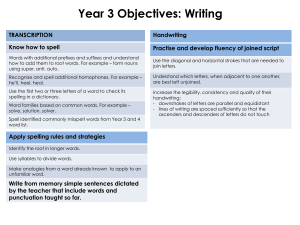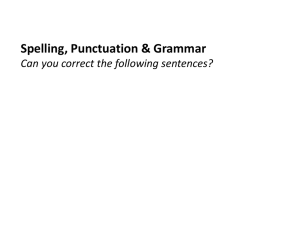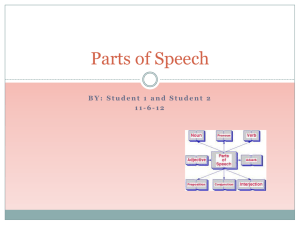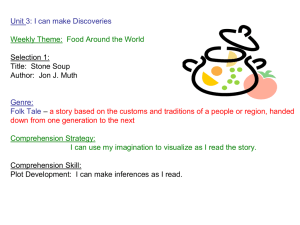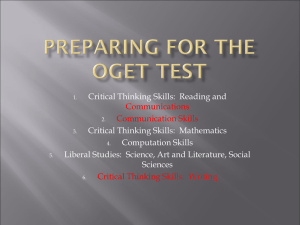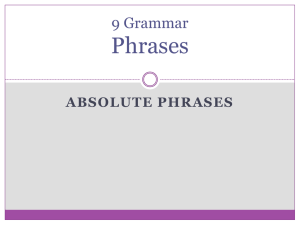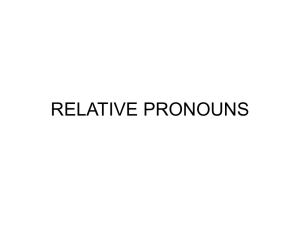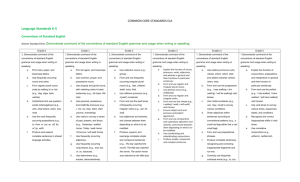Common Core Grammar
advertisement
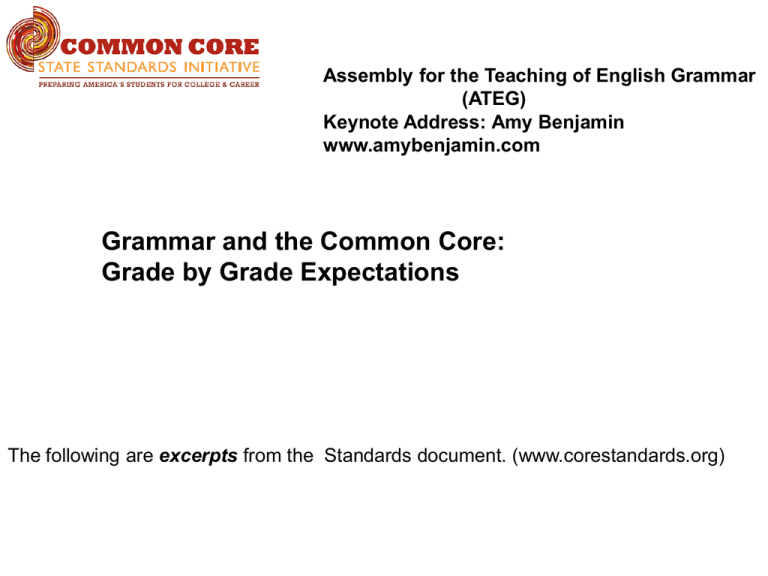
Assembly for the Teaching of English Grammar (ATEG) Keynote Address: Amy Benjamin www.amybenjamin.com Grammar and the Common Core: Grade by Grade Expectations The following are excerpts from the Standards document. (www.corestandards.org) At-A-Glance: 32 Common Core Anchor Standards for Literacy (grades 3-12) Reading: Writing: Key Ideas & Details: Types & Purposes: 1. Read closely. 2. Track themes & summarize main ideas. 3. Understand and follow progressions. Craft and Structure: 4. Know what words & phrases mean in context. 5. Analyze how the details contribute to each other and to the overall meaning. 6. Assess how point of view or purpose affects meaning. Integration of Knowledge & Ideas : 7. Understand charts, graphs, and other numerical representations. 8. Judge the validity of an argument, based on the language used. 9. Compare texts on the same subject. 10 Comprehend complex text independently. 1. Write arguments. 2. Write informative/ explanatory texts 3. Write narratives. Speaking/Listening Comprehension & Collaboration: Language Knowledge of Language: 1. Know the rules of formal standard written 1.Develop socially appropriate conversational and spoken English and apply them when your skills. audience expects you to do 2. Verbally summarize Production & Distribution: so. Accurately perceive the information that you’ve 4.Match your style to the circumstances when your heard, read, or seen. expectations of your audience expects you to use 3. Assess the credibility audience. : of what you read and hear, a formal language tone. 5. Use the writing process 2. The above includes the based on the language 6. Use technology as a visuals of writing: spelling, used. collaborative tool. capitalization, punctuation. Presentation of Ideas 3. Understand that language Research: is a changing social contract. and Knowledge: 7. Conduct short as well Make effective choices. as more sustained research 4. Present meaningful ideas Expand your understanding of projects. and information coherently the language choices of 8. Gather information from and courteously. others. multiple sources. Judge the 5. Enhance formal Vocabulary credibility of the sources. presentations with visuals, 9. Use both literary and Acquisition and Use: including digital media. informational texts to support, 6. Know the rules of formal 4. Figure out what new words inform, and enrich your claims spoken English and apply & phrases mean using context, them when appropriate to the word parts, dictionaries, a 10. Write routinely; both audience. 5. Understand that words can formally and informally; write be nuanced and can have polished pieces and on-demand; multiple meanings. write to express knowledge and 6. Understand and use an to formulate it. Revise, proofread, academic/businesslike level edit. of language. Explicit, direct connection to grammar education Language 1. Know the rules of formal standard written and spoken English and apply them when your audience expects you to do so. Accurately perceive the circumstances when your audience expects you to use : a formal language tone. 2. The above includes the visuals of writing: spelling, capitalization, punctuation. What are the Standards having an implicit, indirect connection to grammar education? 3. Understand that language is a changing social contract. Make effective choices. Expand your understanding of the language choices of others. The Standards English Language Arts & Literacy in History/Social Studies, Science, Technical Subjects “Curriculum Spiral”: Same set of standards applied to increased level of text complexity as students move up the grade levels “Teach less, learn more” Mathematics Specific strands of math are taught at given grade levels. I teaching grammar. I never “really” learned it. Shouldn’t they already have had this in the lower grades? Do kids really have to learn all these terms? I loved it! I thought diagramming sentences was fun! There’s no interesting way to teach grammar. It’s just drill and workbook. M Grammar-Related Standards: Kindergarten Excerpts: In speech: Form regular plurals in speech (-s or –es) Use questions words (who, what, when, where, why, how) in speech Use common prepositions in speech (to, from, in, out, on, off, for, of, by, with) Produce and expand complete sentences in shared language activities In writing: Capitalize the first word of a sentence; Capitalize the pronoun I Recognize and name end punctuation Write a letter(s) for most consonant and short-vowel sounds (phonemes) Spell simple words phonetically, drawing on knowledge of sound-letter relationships Grammar-Related Standards: First Grade Excerpts: In speech and writing: Print all upper and lower-case letters Basic subject-verb agreement Personal pronouns, including possessive pronouns (their/they, etc.) Variety of verb tenses Prepositions such as during, beyond, toward, before, after Produce and expand complete simple and compound sentences (declarative, interrogative, imperative, exclamatory) In writing: Capitalize dates, names of people Use end punctuation for sentences Use commas in dates and to separate single items in a series Use basic rules of phonics to spell taught and untaught words that are common and that comport with basic phonetic rules Grammar-Related Standards: Second Grade Conventions of Standard English: Form and use common irregular plurals. Use reflexive pronouns (myself, themselves, etc.) Form and use common irregular verbs. Make the correct choice between an adjective or an adverb, depending upon what is to be modified. Expand and rearrange sentences by adding or moving words and/or phrases. Capitalize holidays, product names, geographic names. Use commas in greetings and closings of letters. Use apostrophes in contractions and possessives. Learn the most basic spelling patterns, generalizations, and rules; Start using dictionaries to check spelling. Knowledge of Language: Compare formal and informal styles of English. Grammar-Related Standards: Third Grade Conventions of Standard English: Explain the function of nouns, pronouns, verbs, adjectives, and adverbs in general and their functions in particular sentences. Form and use regular and irregular plural nouns. Use abstract nouns. Form and use regular and irregular verbs. Form and use the simple verb tenses (I walk, I walked, I will walk). Ensure subject-verb and pronoun-antecedent agreement. Form and use comparative and superlative adjectives and adverbs, choosing correctly between them depending on what is being compared. Use coordinating and subordinating conjunctions. Produce simple, compound, and complex sentences. Capitalize titles appropriately. Use commas in addresses and in dialogue (along with quotation marks). Use and form possessives. Follow the most frequent and reliable spelling rules for adding suffixes and prefixes; learn common spelling patterns, generalizations, and rules Knowledge of Language: Understand that there are differences in language use between speech and writing. Grammar-Related Standards: Fourth Grade Conventions of Standard English: Use relative pronouns (who, whose, whom, which, that) and relative adverbs (where, when, why). Form and use the progressive (e.g., I was walking, I am walking, I will be walking) verb tense; use modal auxiliaries (would, could, should, will, shall, may, might, must) to express various conditions. Recognize and correct fragments and run-ons. Make the correct choice of common homophones (too, to, two; there, their, etc.). Use correct capitalization. Use commas and quotation marks to write direct quotations. Use a comma before a coordinating conjunction (and, but, so, or, etc.) in a compound sentence. Knowledge of Language: Choose punctuation for effect. Differentiate between circumstances that call for formal Standard English and those that call for a more informal register of English. Grammar-Related Standards: Fifth Grade Conventions of Standard English: Explain the function of conjunctions, prepositions, and interjections in general and their function in particular sentences. Form and use the perfect (e.g., I had walked; I have walked; I will have walked) verb tenses. Use verb tense to convey various times, sequences, states, and conditions. Recognize and correct inappropriate shifts in verb tense. Use correlative conjunctions (e.g., either/or, neither/nor) Use a comma to separate: items in a series introductory elements from the rest of the sentence the words yes and no from the rest of the sentence (in answer to a question) tag questions (…, isn’t it?, …, don’t you?) from the rest of the sentence names of people in direct address from the rest of the sentence Use underlining, quotation marks, or italics to indicate titles of works. Grammar-Related Standards: Fifth Grade (continued) Knowledge of Language: Expand, combine, and reduce sentences for meaning, reader/listener interest, and style. Compare and contrast the varieties of English (e.g., dialects, registers) used in stories, dramas, or poems. Note: Spelling Fifth grade is the last grade in which the term “gradeappropriate words” is used in regard to spelling. After fifth grade, students are expected to just “spell correctly,” using references as needed and as appropriate. Grammar-Related Standards: Sixth Grade Conventions of Standard English: Ensure that pronouns are in the proper case (subjective, objective, possessive). Use intensive pronouns (myself, ourselves). Recognize and correct inappropriate shifts in pronoun number and person Recognize and correct vague pronouns (i.e., ones with unclear or ambiguous antecedents). Recognize variations from standard English in their own and others' writing and speaking, and identify and use strategies to improve expression in conventional language. Use punctuation (commas, parentheses, dashes) to set off nonrestrictive/parenthetical elements. Knowledge of Language: Vary sentence patterns for meaning, reader/listener interest, and style. Maintain consistency in style and tone. Grammar-Related Standards: Seventh Grade Conventions of Standard English: Explain the function of phrases and clauses in general and their function in specific sentences. Choose among simple, compound, complex, and compound-complex sentences to signal differing relationships among ideas. Place phrases and clauses within a sentence, recognizing and correcting misplaced and dangling modifiers. Use a comma to separate coordinate adjectives (e.g., It was a fascinating, enjoyable movie but not He wore an old[,] green shirt). Knowledge of Language: Use knowledge of language to eliminate awkwardness and wordiness. Grammar-Related Standards: Eighth Grade Conventions of Standard English: Explain the functions of verbals (gerunds, participles, infinitives) in general, and their function in particular sentences. Form and use verbs in the active and passive voice. Form and use verbs in the indicative, imperative, interrogative, conditional, and subjunctive mood. Recognize and correct inappropriate shifts in verb tense, voice, and mood. Use commas, ellipsis, dashes to signal pauses and/or breaks. Knowledge of Language: Use verbs in the active or passive voice and in the conditional and subjunctive mood to achieve particular effects (e.g., to emphasize the actor or the action; expressing uncertainty; describing a state contrary to fact). Grammar-Related Standards: Ninth-Tenth Grade Conventions of Standard English: Use parallel structure. Use various types of phrases (noun, verb, adjectival, adverbial, prepositional, participial, absolute) and clauses (independent, dependent, noun, relative, adverbial) to convey specific meanings and achieve a varied style. Use a semicolon. Use a colon. Knowledge of Language: Edit, conforming to a given style guide, such as MLA, Chicago Manual of Style, Turabian. Grammar-Related Standards: Eleventh-Twelfth Grade Conventions of Standard English: Apply the understanding that usage is a matter of convention, can change over time, and is sometimes contested. Resolve issues of complex and contested usage, consulting references. Demonstrate commands of the rules of standard English capitalization, punctuation, and spelling in writing. Observe the rules of hyphenation. Knowledge of Language: Vary syntax for effect, consulting references (Tufte’s Artful Sentences) as needed; apply an understanding of syntax to the study of complex texts when reading.
